Tatbir
Tatbir (Arabic: تطبير), also known as Talwar zani and Qama Zani in Iran and South Asia,[1] is a form of ritual bloodletting, practiced as an act of mourning by Shia Muslims (it is a forbidden act according to most Grand Ayatollahs) for the younger grandson of Muhammad, Husayn ibn Ali, who was killed along with his children, companions and near relatives at the Battle of Karbala by the Umayyad Caliph Yazid I. The practice was first introduced by the Qizilbash tribe who were instrumental in establishing the Safavid rule.[2] Tatbir is a contested issue among Shia. Most clerics deem it to be self-harm and hence haram. However, a small minority of Shia do perpetuate the practice in defiance.
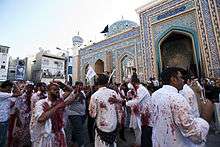
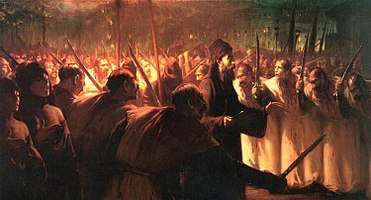
Performance of Tatbir
Tatbir is practiced by some Shia Muslims on the 10 Muharram of the Islamic calendar, known as "the Day of Ashura", and on the 40th day after Ashura, Known as "Arba'een/Chehelom" by Twelvers around the world. Some Shia may also perform tatbir on other occasions as well.
The practice of Tatbir includes striking oneself with a form of a talwar "sword" on the head, causing blood to flow in remembrance of the innocent blood of Imam Husayn. Some Twelvers also hit their back and/or chest with blades attached to chains.
Views of psychotraumatologists
Tatbir can be considered a form of physical/religious/ritual abuse. A recent study among 200 Iranian university students showed that 12.5% of students reported being victimized by at least one form of religious/ritual abuse. Among these, 3 individuals reported performing, or being persuaded to perform, tatbir (qame-zani in Persian). In this empirical study which was published in the Journal of Interpersonal Violence, Nobakht and Dale concluded that being victim of religious/ritual abuse, in general, and being persuaded to injure oneself (as in tatbir), in particular, might play an important role in genesis of dissociative disorders.[3]
Fatwas
Tatbir is contested among Shia clerics. While some traditionalist clerics allow believers to indulge in tatbir, modernist clerics deem it impermissible because it is considered self-harm, thus haram in Islam.[4] Most religious authorities associate all forms of self-flagellation and blood-letting as ways to relate to painful deaths during the battle of Karbala by Imam Husayn and supporters.[5]
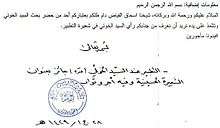
| # | Image | Marja' | Fatwa | Description |
|---|---|---|---|---|
| 1 | 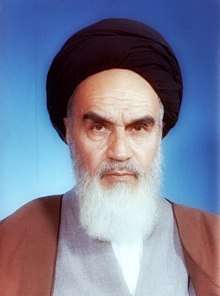 |
Ruhollah Khomeini | It should not be practised today | "No problem in performing this act (tatbir), but try to avoid it during these days."[6] "There is no obstacle if it doesn't cause harm, but it shouldn't be practised today."[7] |
| 2 | .jpg) |
Abu al-Qasim al-Khoei | Impermissible if it causes harm | Many Grand Ayatollahs state that Ayatollah Khoei allowed tatbir like: Mirza Jawad Tabrezi,[8] Ayatollah Bahjet,[9] Safi Golpaygani,[10] Muhammad Shahroudi, [11] Mofti al-Shia,[12] Sadiq Hussain Shirazi[13] and Taqi Tabatabei Qomi.[14] In a question asked about tatbir with the assumption that it does not cause harm he replied: "There is no problem in performing such act in itself according to the assumption in the question".[15]
"If blood matam and hitting oneself with chains, which are practiced in Muharram, cause serious harm, or harm or ridicule the religion and sect then it is impermissible."[16] |
| 3 | 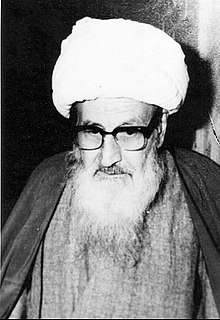 |
Mohammad Ali Araki | Permissible if it does not cause harm | "If it doesn't cause any harm to the body or that there is no danger of dying from this act, then it is permissible (allowed)".[17] |
| 4 | 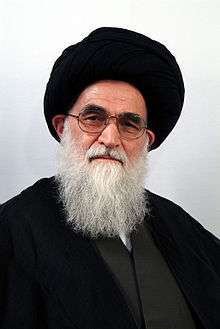 |
Sayyid Sadeq Rohani | Not forbidden | He said: "I love the youths that do tatbir /Qama Zani and I ask Allah to resurrect me with them." |
| 5 |  |
Ali Sistani | Did not given any fatwa on Tatbir. | Refer to another Marja for guidance on this issue [18] "Reviving Hussaini traditions is Mustahabb but one is not allowed to harm the body or the noble reputation of the faith."[19] |
| 6 |  |
Ali Khamenei | Forbidden | Ali Khamenei, Supreme Leader of Iran has stated that Tatbir is forbidden.[20] "Tatbir is a wrongful act ... Tatbir [Qame Zani] is also a fabricated tradition ...Do not practice it, I do not approve. If someone does anything to display their desire to practice Tatbir, I will be deeply disappointed in them."[21] |
| 7 |  |
Naser Makarem Shirazi | Forbidden | Muslims should avoid actions that display weakness in the Shia religion and damage the body.[18] |
| 8 | .jpg) |
Mohammad Fazel Lankarani | Forbidden | Tatbir shows the harsh face of mourning of Husayn ibn Ali and it harms Shiism.[18][22] |
| 9 | 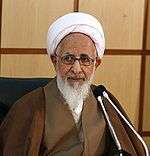 |
Abdollah Javadi-Amoli | Forbidden | It is not permissible to insult Islam and the desecration of mourning. Therefore, it is better to avoid Tatbir and things like that.[18] |
| 10 |  |
Mohammad-Taqi Bahjat Foumani | Forbidden | It should be avoided; every act that would be an insult to the Shia.[18] |
| 11 | 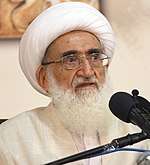 |
Hossein Noori Hamedani | Forbidden | Should be avoided as actions that weakens the Shia religious.[18][22] |
| 12 | 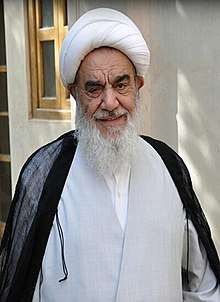 |
Hossein Mazaheri | Forbidden | When Wali e Faqih (Guardian Jurist) orders to avoid something, all people have to avoid it, even if they do not follow Guardian Jurist.[18] |
| 13 | 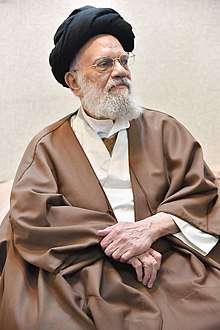 |
Kazem al-Haeri | Forbidden | Tatbir is a superstition that causes the defamation of Islam and Shia Islam in particular.[18] |
| 14 | Mohaqiq Kabuli | Forbidden | There is no allowance to practice Tatbir or self-flagellation or something else that is considered as self-harm. | |
| 15 | 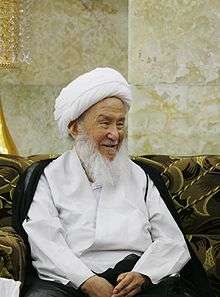 |
Muhammad al-Fayadh | Permissible if it does not cause serious harm to the body | Tatbir is permissible, if it does not cause serious damage to the body.[23] |
| 16 | Muhammad Saeed al-Hakim | Recommended if it does not cause harm[24] | Tatbir as one form of the mourning of Husayn ibn Ali is permissible. It is permitted under the intention of sympathy with God and trust-seeking, to promote searching for trust.
"Religious rituals that Shias perform to mourn the tragedies of the Imams of the Ahlulbait (peace be upon them) and to present the oppressions that they suffered are recommended. However, it is obligatory to avoid what causes harm to the soul or the body. If it does not result in harm, it remains being recommended. One should avoid performing them in a place where the reputation of the Shias is damaged."[25] There are no narrations that mention that "the Imams (peace be upon them) shed their own blood because of their sadness and grief for what happened to Imam Hussein (peace be upon him)".[26] | |
| 17 | .jpg) |
Hossein Vahid Khorasani | Forbidden during the present circumstances[27] | "The Ayatullah also goes over the Fatwas (verdicts) of previous scholars on the Mourning rituals and he even states that shedding blood for the sake of mourning Ahlulbayt is Halal (lawful)."[28] |
| 18 | 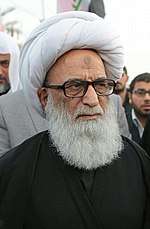 |
Bashir al-Najafi | Not Forbidden | "Tatbir is permitted until it describes sorrow for Imam Hussain".[29] |
| 19 | 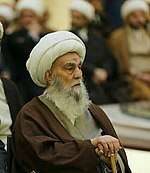 |
Shamsodin Vaezi | Not forbidden | "Tatbir is permissible (allowed) and the issue is described in detail in our book Al-Husseini rituals".[30] |
| 20 |  |
Lotfollah Safi Golpaygani | Not forbidden | The Grand Ayatollah Sheikh Safi Gulpaygani described the Husseini rituals as a link between all Shiites around the world, including the self-flagellation rituals(Qama Zani or Zanjeer Zani).[31] |
| 21 |  |
Jawad Tabrizi | Problematic | "Tatbir is permissible (allowed) and it is a Mustahab act, this is due to some narrations which state that: When sayyida Zainab saw Imam Hussain's head, she smashed her head into a rock and blood flowed from her head"[32]
"The inclusion of the aforementioned (acts like tatbir) under the category of recommended grief for what occurred to the Master of Martyrs is problematic/doubtful."[33][34] |
Criticisms
- Tatbir is a mourning ceremony that calls for self-flagellation and consequent blood shedding. At the ceremony, mourners strike themselves with daggers/blades on their head and other parts of their body. It is considered unsanitary as blood introduced into environment through open wounds of mourners can carry dangerous diseases, such as hepatitis B (HBV), human immunodeficiency virus (HIV), hepatitis C (HCV), syphilis, malaria, brucellosis, babesiosis, leptospirosis, arborviral infections, relapsing fever, [[Creutzfeldt–Jakob disease], and viral hemorrhagic fever (Ebola virus).
- Tatbir can also cause disturbances in the mental balance of people of society gathering to view it.[35][36]
- There are different opinion about the practice of Tatbir. Shia believes that it is a form of self-harm, so it must be forbidden. Others who practice Tatbir consider it as "folk practice". According to some sects of Shia, it is felt Tatbir reflects on Shia observers poorly, so they typically avoid it in a region where Sunnis also reside. Abbas Shams al-Din, a Shia cleric, said: "these practices used to be limited and no one paid attention to them, but they have started to spread and defame the image of the event in a huge way."[37]
- Iraqi sociologist Ibrahim al-Haidari has called Tatbir an irrational act. He states blood donations should replace Tatbir. Iraqi cleric Hussein Al-Sadr and his followers donate blood every year during the mourning of Husayn ibn Ali. [38]
- Hassan Nasrallah, the leader of Hezbollah in Lebanon, has also taken steps to end Tatbir. Instead of practicing Tatbir, he offered to donate blood on Ashura day to patients who need it.[37]
- Mohammad Mehdi Shamseddine established a blood bank in Najaf to donate blood on Ashura day to patients who need it.[39]
References
- "Fatwa on Tatbir [Qama Zani]". Pasbaan-e-Aza. Archived from the original on September 10, 2009. Retrieved 2010-07-03.
- []
- Nobakht, Habib Niyaraq; Dale, Karl Yngvar (2018-10-02). "An exploration of the roles of trauma and dissociation in mystical experiences and near-death experiences". Journal of Spirituality in Mental Health. 20 (4): 321–332. doi:10.1080/19349637.2018.1439796. ISSN 1934-9637.
- Monsutti, Alessandro; Naef, Silvia; Sabahi, Farian (2007). The Other Shiites: From the Mediterranean to Central Asia. Peter Lang. pp. 146–. ISBN 978-3-03911-289-0. Retrieved 2015-09-30.
- Tabbaa, Yasser; Mervin, Sabrina (28 July 2014). Najaf, the Gate of wisdom. UNESCO. pp. 154–. ISBN 978-92-3-100028-7.
- Istaftaat e Imam Khomeini-Vol 3 استفتأت امام خمينى
- Estefta'at-e Emam Khomeini, vol. 3, p. 581 and 583 - Imam Khomeini's website
- "یا زینب کبری". 29 September 2008. Archived from the original on 29 September 2008.
- "یا زینب کبری". 29 September 2008. Archived from the original on 29 September 2008.
- "یا زینب کبری". 29 September 2008. Archived from the original on 29 September 2008.
- "یا زینب کبری". 29 September 2008. Archived from the original on 29 September 2008.
- "یا زینب کبری". 29 September 2008. Archived from the original on 29 September 2008.
- "یا زینب کبری". 29 September 2008. Archived from the original on 29 September 2008.
- "یا زینب کبری". 29 September 2008. Archived from the original on 29 September 2008.
- http://shiamatam.com/wp-content/uploads/2016/10/Ayatullah-Khui-e1475417637360.jpeg
- Al-Masa’il al-Shar’iyah, istifta’at Imam Khoei, al-Ibadat and al-Tariq al-Najah, v.2, p.445 - Tatbir.org
- "Ayatollah Muhammad Ali Araki's Fatwa".
- "opinions of the Maraj'e in regard to using Qama". Retrieved 19 October 2015.
- Tatbir. "Fatawa : Tatbir - A Disturbing Innovation". Retrieved 2019-05-10.
- "Tatbir is a wrongful and fabricated tradition: Imam Khamenei". Khamenei.ir. 7 October 2016.
- "Tatbir is a wrongful and fabricated tradition: Imam Khamenei". Khamenei.ir. 2016-10-07. Retrieved 2019-05-10.
- "What are the opinions of the Maraj'e in regard to using Qama in the past and in present time?". Retrieved 19 October 2015.
- "Grand Ayatollah Mohammad Ishaq al-Fayyad response to Tatbir". Retrieved 26 October 2015.
- "Office of Grand Ayatollah Sayyid M.S.Al-Hakeem". alhakeem.com. Retrieved 2019-05-09.
- "Office of Grand Ayatollah Sayyid M.S.Al-Hakeem". alhakeem.com. Retrieved 2019-05-09.
- "Office of Grand Ayatollah Sayyid M.S.Al-Hakeem". alhakeem.com. Retrieved 2019-05-09.
- "نظر آیت الله وحیدخراسانی در مورد قمه زنی چیست؟". فتن. 2015-10-30. Retrieved 2019-05-09.
- "Qom's leading cleric: Shedding blood in Azadari "lawful" - Jafariya News Network". www.jafariyanews.com.
- "Tatbir Fatawa by Shia Mujtahideen and Scholars". ShiaMatam.com.
- "مكتب آية الله العظمى الشيخ شمس الدين الواعظي ـ دام ظله". 9 April 2010. Archived from the original on 9 April 2010.
- "Grand Ayatollah Shaikh Safi Gulpaygani: Husseini rituals are the link between Shiites around the world - ShiaWaves English". shiawaves.com.
- "الشعائر الحسينية والعزاء - موقع فقیه مقدس استاد الفقهاء آیة الله العظمی المیرزا جواد التبریزی ره".
- Sirat al-Najat, v. 2, Q 1404 - Tatbir.org
- "بررسی فتوای میرزای نایینی در جواز قمهزنی « مباحثات". مباحثات (in Persian). Retrieved 2019-05-09.
- "Tatbir". Tatbir.org. Retrieved 2016-01-05.
- Masaeli, Mahdi. "Tatbir" (PDF). Fetan. Golban Publication.
- Hubbard, Ben (2014-11-05). "Bloody and Belittled Shiite Ritual Draws Historic Parallels". The New York Times Company.
- Mamouri, Ali (2014-12-26). "Iraqi Shiite pilgrimage takes political turn". Al-Monitor.
- "Mohammad Mehdi Shamseddine" (in Persian). nbo.ir.